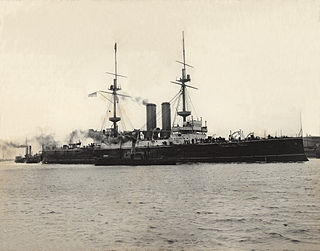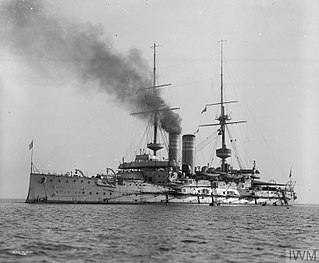| 9th Battle Squadron | |
|---|---|
 | |
| Active | July 1914 – August 1914 |
| Country | |
| Branch | |
| Size | Squadron |
The 9th Battle Squadron was a short-lived squadron of the British Royal Navy consisting of battleships serving in the Grand Fleet. [1]
| 9th Battle Squadron | |
|---|---|
 | |
| Active | July 1914 – August 1914 |
| Country | |
| Branch | |
| Size | Squadron |
The 9th Battle Squadron was a short-lived squadron of the British Royal Navy consisting of battleships serving in the Grand Fleet. [1]
The 9th Battle Squadron was formed at Grimsby on 27 July 1914, and comprised a number of the older Majestic-class pre-dreadnought battleships. These included: [2]
Due to the age and obsolescence of its constituent vessels, on 7 August 1914 the 9th Battle Squadron was dissolved and the ships were allocated to guard ship duty.

The Grand Fleet was the main battlefleet of the Royal Navy during the First World War. It was established in August 1914 and disbanded in April 1919. Its main base was Scapa Flow in the Orkney Islands.

The Home Fleet was a fleet of the Royal Navy that operated from the United Kingdom's territorial waters from 1902 with intervals until 1967. In 1967, it was merged with the Mediterranean Fleet creating the new Western Fleet.
The 5th Battle Squadron was a squadron of the British Royal Navy consisting of battleships. The 5th Battle Squadron was initially part of the Royal Navy's Second Fleet. During the First World War, the Home Fleet was renamed the Grand Fleet.

HMS Victorious was one of nine Majestic-class pre-dreadnought battleships of the British Royal Navy. She was armed with a main battery of four 12-inch (305 mm) guns in two twin turrets, and was capable of a top speed of 16 knots. She served primarily on home waters, and participated in the Fleet Review for the Diamond Jubilee for Queen Victoria in 1897. She served briefly in the Mediterranean in 1898 before being transferred to the China Station later that year; Victorious remained in East Asian waters until 1900, when she returned to the Mediterranean.

HMS Africa was a pre-dreadnought battleship of the Royal Navy, and the penultimate ship of the King Edward VII class. The ship was built by Chatham Dockyard between 1904 and 1906. Armed with a battery of four 12-inch (305 mm) and four 9.2 in (234 mm) guns, she and her sister ships marked a significant advance in offensive power compared to earlier British battleship designs that did not carry the 9.2 in guns. Like all ships of the class, she was named after an important part of the British Empire, namely Africa.

The British Mediterranean Fleet, also known as the Mediterranean Station, was a formation of the Royal Navy. The Fleet was one of the most prestigious commands in the navy for the majority of its history, defending the vital sea link between the United Kingdom and the majority of the British Empire in the Eastern Hemisphere. The first Commander-in-Chief for the Mediterranean Fleet was the appointment of General at Sea Robert Blake in September 1654. The Fleet was in existence until 1967.

HMS Britannia was a King Edward VII-class pre-dreadnought battleship of the Royal Navy. She was named after Britannia, the Latin name of Great Britain under Roman rule. The ship was built by Portsmouth Dockyard between 1904 and 1906. Armed with a battery of four 12-inch (305 mm) and four 9.2 in (234 mm) guns, she and her sister ships marked a significant advance in offensive power compared to earlier British battleship designs that did not carry the 9.2 in guns.

HMS Commonwealth was a King Edward VII-class battleship of the British Royal Navy. Like all ships of the class she was named after an important part of the British Empire, namely the Commonwealth of Australia. Armed with a battery of four 12-inch (305 mm) and four 9.2 in (234 mm) guns, she and her sister ships marked a significant advance in offensive power compared to earlier British battleship designs that did not carry the 9.2 in guns. Commonwealth was built at the Fairfield Shipbuilding and Engineering Company, and was laid down in June 1902, launched in May 1903, and completed in March 1905.
The 6th Battle Squadron was a squadron of the British Royal Navy consisting of Battleships serving in the Grand Fleet and existed from 1913 to 1917.

HMS Hannibal was a Majestic-class pre-dreadnought battleship built for the Royal Navy, and the sixth ship to bear the name HMS Hannibal. The ship was laid down at the Pembroke Dock in May 1894, she was launched in April 1896, and commissioned into the fleet in April 1898. She was armed with a main battery of four 12-inch (305 mm) guns and a secondary battery of twelve 6-inch (152 mm) guns. The ship had a top speed of 16 knots.

HMS Duncan was the lead ship of the six-ship Duncan class of Royal Navy pre-dreadnought battleships. Built to counter a group of fast Russian battleships, Duncan and her sister ships were capable of steaming at 19 knots, making them the fastest battleships in the world. The Duncan-class battleships were armed with a main battery of four 12-inch (305 mm) guns and they were broadly similar to the London-class battleships, though of a slightly reduced displacement and thinner armour layout. As such, they reflected a development of the lighter second-class ships of the Canopus-class battleship. Duncan was built between her keel laying in July 1899 and her completion in October 1903.
The 3rd Battle Squadron was a naval squadron of the British Royal Navy consisting of battleships and other vessels, active from at least 1914 to 1945. The 3rd Battle Squadron was initially part of the Royal Navy's Home Fleet. During the First World War, the Home Fleet was renamed the Grand Fleet. During the Second World War, the squadron covered Atlantic convoys.

The Battle Cruiser Fleet, (BCF), later known as Battle Cruiser Force, a naval formation of fast battlecruisers of the Royal Navy, operated from 1915 to 1919.

The 7th Battle Squadron was a squadron of the British Royal Navy assembled prior to World War I it was assigned to the Third Fleet and consisted of pre-dreadnought type battleships the oldest ships in fleet it existed from 1912 to 1914.

The 8th Battle Squadron was a squadron of the British Royal Navy assembled prior to the beginning of World War I; it was later assigned to the Third Fleet. The squadron consisted of pre-dreadnought type battleships. It existed from 1912 to 1914.
The 1st Division was a formation of the Home Fleet of the Royal Navy. It briefly existed before the First World War from 1909 to 1912.

During the First World War, the Commander-in-Chief at the Cape, Rear Admiral Herbert King-Hall, expended much effort to destroy the elusive German light cruiser Königsberg.
The British 3rd Destroyer Flotilla, also styled as Third Destroyer Flotilla, was a naval formation of the Royal Navy from 1909 to 1939 and again from 1945 to 1951.